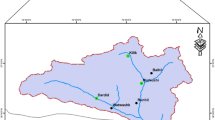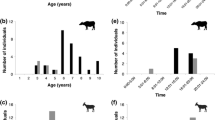Abstract
Alleviating human–carnivore conflict is central to large carnivore conservation and is often of economic importance, where people coexist with carnivores. In this article, we report on the patterns of predation and economic losses from wild carnivores preying on livestock in three villages of northern Baima Xueshan Nature Reserve, northwest Yunnan during a 2-year period between January 2010 and December 2011. We analyzed claims from 149 households that 258 head of livestock were predated. Wolves (Canis lupus) were responsible for 79.1 % of livestock predation; Asiatic black bears (Selenarctos thibetanus) and dholes (Cuon alpinus) were the other predators responsible. Predation frequency varied between livestock species. The majority of livestock killed were yak–cattle hybrids or dzo (40.3 %). Wolves killed fewer cattle than expected, and more donkeys and horses than expected. Wolves and bears killed more adult female and fewer adult male livestock than expected. Intensified predation in wet season coincided with livestock being left to graze unattended in alpine meadows far away from villages. On average, carnivore attacks claimed 2.1 % of range stock annually. This predation represented an economic loss of 17 % (SD = 14 %) of the annual household income. Despite this loss and a perceived increase in carnivore conflict, a majority of the herders (66 %) still supported the reserve. This support is primarily due to the benefits from the collection of nontimber resources such as mushrooms and medicinal plants. Our study also suggested that improvement of husbandry techniques and facilities will reduce conflicts and contribute to improved conservation of these threatened predators.




Similar content being viewed by others
References
Agarwala M, Kumar S, Treves A, Naughton-Treves L (2010) Paying for wolves in Solapur, India and Wisconsin, USA: comparing compensation rules and practices to understand the goals and politics of wolf conservation. Biol Conserv 143:2945–2955
Bagchi S, Mishra C (2006) Living with large carnivores: predation on livestock by the snow leopard (Uncia uncia). J Zool 268:217–224
Ballard WB, Whitman JS, Gardner CL (1987) Ecology of an exploited wolf population in south-central Alaska. Wildl Monogr 98:1–54
Conforti VA, de Azevedo FCC (2003) Local perceptions of Jagurs (Panthera onca) and pumas (Puma concolor) in the Iguacu National Park area, south Brazil. Biol Conserv 111:215–221
Cozza K, Fico R, Battistini ML, Rogers E (1996) The damage–conservation interface illustrated by predation on domestic livestock in central Italy. Biol Conserv 78:329–336
Dar NI, Minhas RA, Zaman Q, Linkie M (2009) Predicting the patterns, perceptions and causes of human–carnivore conflict in and around Machiara National Park, Pakistan. Biol Conserv 142:2076–2082
Dickman AJ, Macdonald E, Macdonald D (2011) A review of financial instruments to pay for predator conservation and encourage human–carnivore coexistence. Proc Natl Acad Sci USA 108:13937–13944
Fuller TK (1989) Population dynamics of wolves in north-central Minnesota. Wildl Monogr 105:1–14
Gazzola A, Bertelli I, Avanzinelli E, Tolosano A, Bertotto P, Apollonio M (2005) Predation by wolves (Canis lupus) on wild and domestic ungulates of the western Alps, Italy. J Zool 266:205–213
Goodrich JM (2010) Human–tiger conflict: a review and call for comprehensive plans. Integr Zool 5:300–312
Graham K, Beckerman AP, Thirgood S (2005) Human–predator–prey conflicts: ecological correlates, prey losses and patterns of management. Biol Conserv 122:159–171
Hemson G, Maclennan S, Mills G, Johnson P, Macdonald D (2009) Community, lions, livestock and money: a spatial and social analysis of attitudes to wildlife and the conservation value of tourism in a human–carnivore conflict in Botswana. Biol Conserv 142:2718–2725
Hussain S (2000) Protecting the snow leopard and enhancing farmers’ livelihoods. Mt Res Dev 20:226–231
Inskip C, Zimmermann A (2009) Human–felid conflict: a review of patterns and priorities worldwide. Oryx 43:18–34
Jackson RM (1991) Snow leopards and other wildlife in the Qomolangma Nature Preserve of Tibet. Snow Line IX:9–12
Jackson RM, Ahlborn G, Gurung M, Ale S (1996) Reducing livestock depredation losses in the Nepalese Himalaya. In: Proceeding of 17th vertebrate pest conference, University of California, Davis, pp 241–247
Jackson R, Mishra C, McCarthy T, Ale S (2010) Snow leopards: conflict and conservation. In: Macdonald DW, Loveridge AJ (eds) The biology and conservation of wild felids. Oxford University Press, Oxford, pp 417–430
Jorgenson JP, Redford KH (1993) Humans and big cats as predators in the Neotropics. Symp Zool Soc Lond 65:367–390
Khan MM (2009) Can domestic dogs save humans from tigers Panthera tigris? Oryx 43:44–47
Kissui B (2008) Livestock predation by lions, leopards, spotted hyenas, and their vulnerability to retaliatory killing in the Maasai steppe, Tanzania. Anim Conserv 11:422–432
Kolowski J, Holekamp K (2006) Spatial, temporal, and physical characteristics of livestock depredations by large carnivores along a Kenyan reserve border. Biol Conserv 128:529–541
Kunkel K, Pletscher DH (1999) Species-specific population dynamics of cervids in a multipredator ecosystem. J Wildl Manag 63:1093–1982
Li X, Buzzard P, Jiang X (2013) Habitat associations of four ungulates in mountain forests of southwest China, based on camera trapping and dung counts data. Popul Ecol. doi:10.1007/s10144-013-0405-2
Mattioli L, Apollonio M, Mazzarone V, Centofanti E (1995) Wolf food habits and wild ungulate availability in the Foreste Casentinesi National Park, Italy. Acta Theriol 40:387–402
Mishra C (1997) Livestock depredation by large carnivores in the Indian trans-Himalaya: conflict perceptions and conservation prospects. Environ Manag 24:338–343
Mishra C, Prins HHT, Van Wieren SE (1997) Overstocking in the trans-Himalayan rangelands of India. Environ Conserv 28:279–283
Mishra C, Allen P, McCarthy T, Madhusudan MD, Bayarjargal A, Prins HHT (2003) The role of incentive programs in conserving the snow leopard. Conserv Biol 17:1512–1520
Myers N, Mittermeier RA, Mittermeier CG, Da Fonseca GAB, Kent J (2000) Biodiversity hotspots for conservation priorities. Nature 403:853–858
Namgail T, Fox JL, Bhatnagar YV (2007) Carnivore-caused livestock mortality in Trans-Himalaya. Environ Manag 39:490–496
Nowak S, Mysłajek RW, Jędrzejewska B (2005) Patterns of wolfCanis lupus predation on wild and domestic ungulates in the Western Carpathian Mountains (S Poland). Acta Theriol 50:263–276
Okarma H (1991) Marrow fat content, sex and age of red deer killed by wolves in winter in the Carpathian Mountains. Holarct Ecol Indic 14:169–172
Okarma H (1995) The trophic ecology of wolves and their predatory role in ungulate communities of forest ecosystems in Europe. Acta Theriol 40:335–386
Oli MK (1991) The ecology and conservation of snow leopard (Panthera uncia) in the Annapurna Conservation Area, Nepal. University of Edinburgh, Edinburgh, p 155
Oli MK, Taylor IR, Rogers ME (1994) Snow leopard Panthera uncia predation on livestock: an assessment of local perceptions in the Annapurna conservation area, Nepal. Biol Conserv 68:63–68
Patterson BD, Kasiki SM, Selempo E, Kays RW (2004) Livestock predation by lions (Panthera leo) and other carnivores on ranches neighboring Tsavo National Parks, Kenya. Biol Conserv 119:507–516
Peterson RO, Woolington JD, Bailey TN (1984) Wolves of the Kenai Peninsula, Alaska. Wildl Monogr 88:1–52
Pettigrew M, Xie Y, Kang A, Rao M, Goodrich J, Liu T, Berger J (2012) Human–carnivore conflict in China: a review of current approaches with recommendations for improved management. Integr Zool 7:210–226
Redpath SM, Thirgood SJ (1999) Numerical and functional responses in generalist predators: hen harriers and peregrines on Scottish grouse moors. J Anim Ecol 68:879–892
Sangay T, Vernes K (2008) Human–wildlife conflict in the Kingdom of Bhutan: patterns of livestock predation by large mammalian carnivores. Biol Conserv 141:1272–1282
Schaller GB, Li H, Lu H, Ren JR, Qiu MJ, Wang HB (1987) Status of large mammals in the Taxkorgan Reserve, Xinjiang, China. Biol Conserv 42:53–71
Schaller GB, Junrang R, Mingjiang Q (1988) Status of the snow leopard Panthera uncia in Qinghai and Gansu Provinces, China. Biol Conserv 45:179–194
Sekhar NU (1998) Crop and livestock depredation caused by wild animals in protected areas: the case of Sariska Tiger Reserve, Rajasthan, India. Environ Conserv 25:160–171
Sogbohossou EA, de Iongh HH, Sinsin B, de Snoo GR, Funston PJ (2011) Human–carnivore conflict around Pendjari Biosphere Reserve, northern Benin. Oryx 45:569–578
Thorn M, Green M, Dalerum F, Bateman PW, Scott DM (2012) What drives human–carnivore conflict in the North West Province of South Africa? Biol Conserv 150:23–32
Treves A, Karanth KU (2003) Human–carnivore conflict and perspectives on carnivore management worldwide. Conserv Biol 17:1491–1499
Treves A, Jurewicz RR, Naughton-Treves L, Rose RA, Willging RC, Wydeven AP (2002) Wolf depredation on domestic animals in Wisconsin, 1976–2000. Wildl Soc Bull 30:231–241
Treves A, Naughton-Treves L, Harper EK, Mladenoff DJ, Rose RA, Sickley TA, Wydeven AP (2004) Predicting human–carnivore conflict: a spatial model derived from 25 years of data on wolf predation on livestock. Conserv Biol 18:114–125
Treves A, Wallace R, White S (2009) Participatory planning of interventions to mitigate human–wildlife conflicts. Conserv Biol 23:1577–1587
Tsering D, Farrington J, Norbu K (2006) Human–wildlife conflict in the Chang Tang region of Tibet. WWF China–Tibet Program, Lhasa
Wang SW, Macdonald D (2006) Livestock predation by carnivores in Jigme Singye Wangchuck National Park, Bhutan. Biol Conserv 129:558–565
Wang S, Xie Y (2004) China species red list. Higher Education Press, Beijing
Woodroffe R, Ginsberg JR (1998) Edge effects and the extinction of populations inside protected areas. Science 280:2126–2128
Worthy FR, Foggin JM (2008) Conflicts between local villagers and Tibetan brown bears threaten conservation of bears in a remote region of the Tibetan Plateau. Human Wildl Confl 2:200–205
Acknowledgments
The study was supported by the Ministry of Environmental Protection of China for biodiversity survey in northwest Yunnan (Y001261051) and partly funded by China Exploration & Research Society (CERS), and the Symrise Corporation. The authors thank the Baima Xueshan Nature Reserve Management Office for their kind support. The authors are also grateful to Jin Lu, Yongsheng Zhang, Qingtao Li, Ji Du, and Bu A for their assistance in the field, and further like to thank three anonymous reviewers for their suggestions that helped in improving the manuscript.
Author information
Authors and Affiliations
Corresponding author
Rights and permissions
About this article
Cite this article
Li, X., Buzzard, P., Chen, Y. et al. Patterns of Livestock Predation by Carnivores: Human–Wildlife Conflict in Northwest Yunnan, China. Environmental Management 52, 1334–1340 (2013). https://doi.org/10.1007/s00267-013-0192-8
Received:
Accepted:
Published:
Issue Date:
DOI: https://doi.org/10.1007/s00267-013-0192-8




